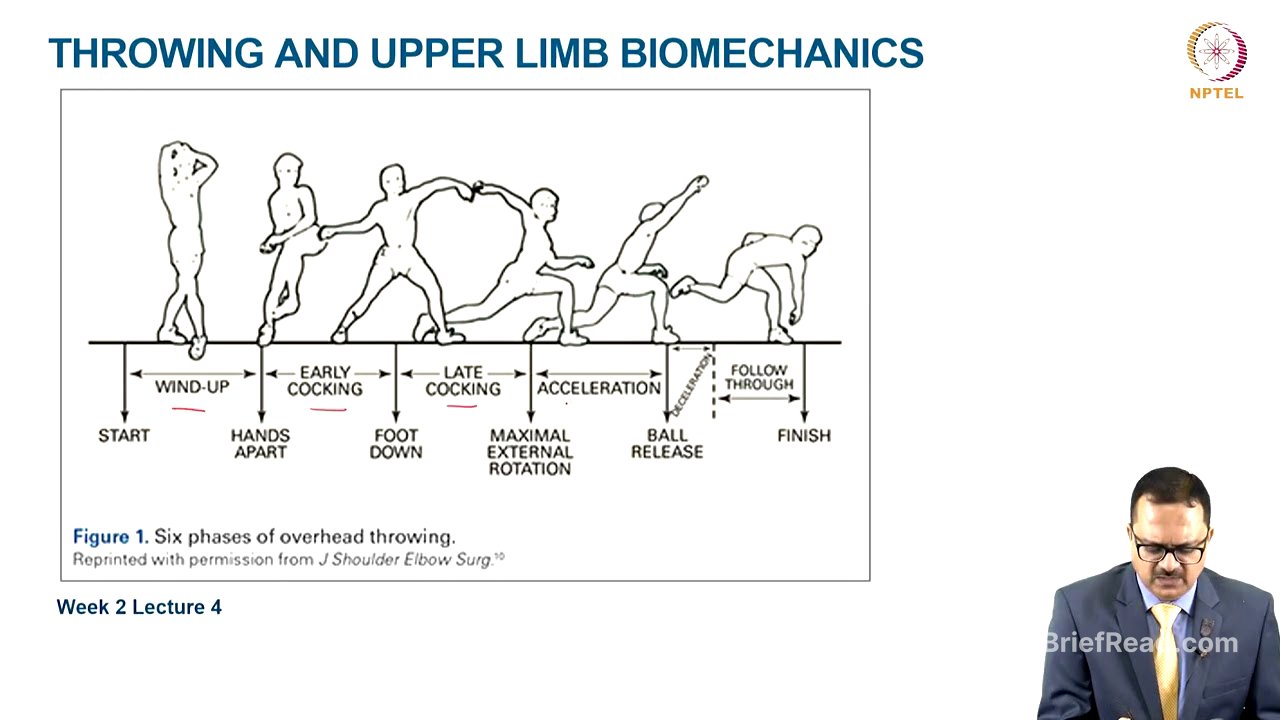TLDR;
This lecture introduces biomechanics and its role in sports injury prevention and rehabilitation. It covers basic principles like Newton's laws of motion, kinematics, kinetics, and tissue mechanics. The lecture also discusses the biomechanics of various activities such as running, jumping, and throwing, as well as common injury mechanisms and the role of technology in biomechanical analysis. It emphasizes the importance of personalized injury prevention strategies, the integration of AI and machine learning, and the development of smart rehabilitation systems.
- Biomechanics is the study of forces and their effects on the human body, crucial for understanding injury mechanisms, prevention, and rehabilitation.
- Key areas include kinematics, kinetics, tissue mechanics, and movement analysis, all based on principles like Newton's laws of motion.
- Understanding biomechanics is essential for optimizing athletic performance and making informed return-to-play decisions.
Introduction to Biomechanics [0:15]
The lecture introduces biomechanics as the study of forces and their effects on the human body, emphasizing its importance in sports medicine for understanding injury mechanisms, preventing injuries, and tailoring rehabilitation strategies. Key areas of biomechanics include kinematics, kinetics, tissue mechanics, and movement analysis. The lecture outline includes basic principles, the role of biomechanics in different activities, tissue biomechanics and injury risk, the role of biomechanics in rehabilitation and return to play, future trends, and a conclusion.
Basic Principles of Biomechanics [1:14]
To study biomechanics, one must understand Newton's laws of motion, including concepts like force (mass times acceleration), torque (twisting force), and momentum. Biological tissues respond differently to load, stress, and strain, with the ability to tear and heal, unlike non-biological materials. Kinematics studies motion without considering forces, focusing on velocity and acceleration, while kinetics examines the forces causing movement, such as ground reaction forces and muscle forces. External forces like gravity and impact forces, as well as internal forces like muscle contraction and ligament tension, play a significant role.
Role of Musculoskeletal System in Biomechanics [3:46]
In biomechanics, bones act as levers and joints act as pivots. Muscles generate and damp force, while ligaments and tendons stabilize joints and facilitate movement. Understanding the force system acting upon joints during muscle activity is crucial. The force of muscle action (FM) upon the joint, the rotary force (F_sub_y), and the compression force or joint stability are all important. Gravitational force (FG) also acts upon the joint, and mechanical advantage is calculated as FM divided by FG.
Biomechanics of Running and Walking [5:26]
Running and walking involve a gate cycle with stance and swing phases, during which ground reaction forces impact the body. Energy efficiency is vital for performance. The stance phase, from heel strike to toe-off, constitutes 60% of the gate cycle, while the swing phase, from toe-off to the next heel strike, makes up 40%. These durations change during running. When jumping and landing, force absorption strategies are important, with knee flexion and ankle dorsiflexion playing a key role. Athletes should be trained to land properly to avoid common landing-related injuries.
Biomechanics of Throwing and Cutting [9:01]
Throwing involves several phases, each generating different forces on the upper limb joints. Shoulder, elbow, and wrist mechanics are critical, and improper throwing mechanics can lead to overuse injuries. Phases include wind-up, early cocking, late cocking, acceleration, and follow-through, with the follow-through phase posing the highest risk for ligament injuries. Cutting and change of direction mechanics rely on agility, foot placement, and knee alignment. High forces act on the anterior cruciate ligament (ACL) during cutting movements, necessitating stability, agility, proper knee alignment, and muscle strengthening around the knee joint.
Common Injury Mechanisms in Sports [11:28]
Common injury mechanisms in sports include acute traumatic injuries influenced by intrinsic and extrinsic risk factors, as well as inciting events. Chronic injuries often result from repetitive stress and inadequate recovery. Injuries can be contact-related, involving collisions with other athletes or equipment, or non-contact, as seen in running. Overuse injuries stem from repetitive stress and insufficient recovery.
Tissue Biomechanics and Injury Risk [12:21]
Understanding tissue biomechanics and injury risk involves recognizing the load tolerance of bones, tendons, and ligaments. Exceeding these limits leads to breakage or tearing. Viscoelastic properties in tendons, ligaments, and muscles offer some protection against injuries, but factors like age, training, and recovery time affect these properties. Ligament injuries, such as ACL tears, often occur due to valgus knee stress during cutting motions. Ankle sprains result from excessive inversion or eversion, while shoulder dislocations can happen with excessive external rotation and abduction.
Muscle Strain, Tendon, and Bone Injuries [14:58]
Muscle strain and tendon injuries are influenced by eccentric and concentric muscle contractions, each with different injury risks. Common sites include the hamstring, quadriceps, and Achilles tendon. Tendinopathy can develop from repetitive strain and inadequate recovery. Bone stress injuries, like stress fractures, result from repetitive bone loading without sufficient recovery, commonly seen in the foot, tibia, and femur of runners and soldiers. Prevention involves proper load management and gradual increases in training load.
Impact Injuries, Concussions, and Overuse Injuries [16:43]
Impact injuries and concussions involve potential linear and rotational trauma to the brain within the skull. A skull trauma on one side can cause brain damage on the opposite side, known as a contrecoup injury. Prevention includes proper helmet design and adherence to safety rules. Overuse injuries, caused by cumulative microtrauma without adequate recovery, commonly manifest as shin splints, rotator cuff tendinopathy, and stress fractures. Proper training load management is crucial for prevention.
Biomechanics of Rehabilitation and Return to Play [19:31]
Rehabilitation involves movement analysis using 2D or 3D motion analysis, with newer markerless 3D motion analysis techniques available. Before returning to play, athletes need proper strength and neuromuscular control training, along with functional testing and certification by a sports physician. Footwear and equipment play a significant role in injury prevention, with well-designed footwear enhancing performance and preventing injuries. Custom-designed orthotics, such as insoles and mouthguards, also contribute to injury reduction.
Gender Differences, Fatigue, and Technology in Biomechanics [22:03]
Gender differences in ligament laxity, muscle activation, and joint alignments influence injury biomechanics, necessitating tailored training and prevention programs. Female athletes face an increased risk of ACL injury and should undergo specific prevention programs. Fatigue impairs neuromuscular coordination and proprioception, increasing injury risk, highlighting the importance of proper conditioning and recovery. Technology, including 2D/3D motion analysis, force plates, and wearable sensors, provides real-time data for injury prevention and performance enhancement.
Future Trends and Conclusion [26:07]
Future trends in biomechanics include personalized injury prevention strategies, integration of AI and machine learning for performance analysis and injury prevention, and the development of smart rehabilitation systems. Biomechanics is essential for understanding injury mechanisms, optimizing performance, and making informed decisions about prevention, rehabilitation, and return to play. Advancements in technology will continue to shape the future of sports biomechanics.









